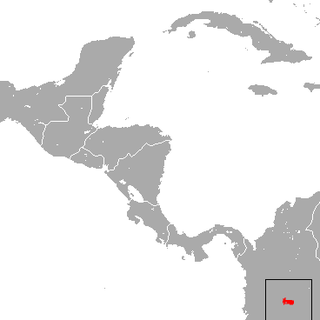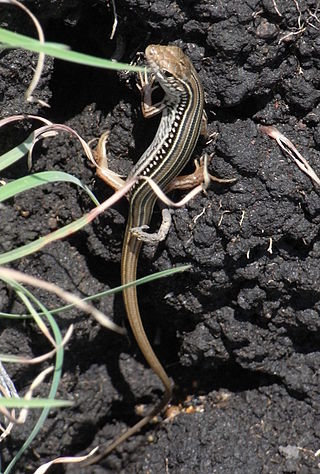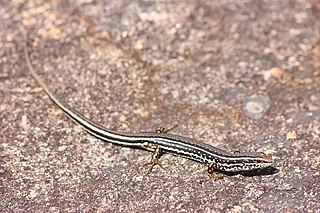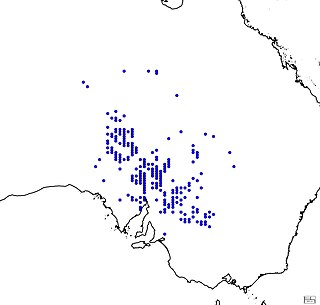The Lancelin Island skink, also known commonly as the Lancelin south-west ctenotus and the south-west ctenotus, is a species of skink, a lizard in the subfamily Sphenomorphinae of the family Scincidae. The species is endemic to Australia.

The Eastern Cordillera small-footed shrew is a species of mammal in the family Soricidae. It is endemic to Colombia, where it is known from the western slopes of the central Cordillera Oriental at elevations from 1,300 to 2,715 m. It resembles C. colombiana. The species is only known from four individuals collected at two localities, the most recent record being from 1925.
The coastal plains skink is a species of skinks, found on the Swan Coastal Plain south of Perth, Western Australia.

The eastern striped skink is a species of skink found in a wide variety of habitats around Australia. They are long-tailed, fast moving skinks that are quite large, growing to a maximum length of about 30 cm. This skink is mostly brown with a white-edged black stripe running down the length of its back and tail with broad brown stripes along the side of the body with rows of white spots. The sides become lighter, turning into an off-white colour towards the underside of the skink, running from the groin to the chin. The striped skink is similar in appearance to the spotted-back skink with the main identifying difference being the solid stripe running down the back of C. robustus whereas C. uber orientalis has a row of dots.

Ctenotus strauchii, also known commonly as the eastern barred wedge-snout ctenotus or Strauch's ctenotus, is a small species of lizard in the family Scincidae. The species is endemic to Australia and is found throughout semi-arid and arid regions in most of Australia's mainland states except Western Australia, although one record does exist for Western Australia in 1975.
The Quinkan ctenotus is a species of Australian skink, a lizard in the family Scincidae.
Ctenotus zebrilla, also known commonly as the Southern Cape York fine-snout ctenotus, is a species of skink, a lizard in the family Scincidae. The species is endemic to Australia.

Ctenotus pantherinus, commonly known as the Leopard Ctenotus, is a species of skink endemic to central and western Australia. Its conservation status is currently classified as Least Concern.

Ctenotus allotropis, the brown-blazed wedgesnout ctenotus, is a species of skink found in New South Wales and Queensland in Australia.
Ctenotus astarte, also known commonly as the stony downs ctenotus, is a species of skink, a lizard in the family Scincidae. The species is endemic to Australia.
Ctenotus eurydice, also known commonly as the brown-backed yellow-lined ctenotus, is a species of skink, a lizard in the family Scincidae. The species is native to New South Wales and Queensland in Australia.
Ctenotus ingrami, also known commonly as Ingram's ctenotus and the unspotted yellow-sided ctenotus, is a species of skink, a lizard in the family Scincidae. The species is native to Queensland and New South Wales in Australia.
Ctenotus joanae, also known commonly as the blacksoil ctenotus and the black-soil ctenotus, is a species of lizard in the subfamily Sphenomorphinae of the family Scincidae (skinks). The species is endemic to Australia.

Ctenotus labillardieri, also known commonly as the common south-west ctenotus, Labillardier's ctenotus, and the red-legged ctenotus, is a species of skink, a lizard in the family Scincidae. The species is endemic to the Australian state of Western Australia.

Ctenotus leonhardii, known by the common names Leonhardi's ctenotus, Leonhardi's skink or common desert ctenotus, is a species of skink found in a range of arid and semi-arid regions throughout mainland Australia. The species was named after German anthropologist Moritz von Leonhardi in 1919 and belongs to the genus Ctenotus, one of the largest genera of lizards in Australia.

Ctenotus olympicus, the olympic ctenotus, spotted ctenotus or saltbush ctenotus, is a species of skink endemic to the arid shrublands of central and southern Australia.

The pale-rumped ctenotus or regal striped skink is a medium-sized species of skink with an arid distribution restricted to the Australian Mainland, which belongs to the largest group of reptiles in Australia, Ctentotus.
Ctenotus spaldingi is a diurnal terrestrial skink (Scincidae) species of lizard, commonly known as the straight-browed ctenotus or Spalding's ctenotus. Native to Australia the species is found in the northern areas of Australia, along the east coast, in the north and east of South Australia and throughout Victoria and in southern Papua New Guinea. Their conservation status is of least concern classified by the IUCN. Individuals can be up to 30cm long from the snout to tail or 10cm long from the snout to vent (SVL). They typically inhabit grasslands and low vegetation in savannah woodlands in coastal dune areas, monsoon scrub and woodland commonly found around rock outcrops and when disturbed will hide in shallow burrows or amongst ground litter.
Ctenotus stuarti, also known commonly as the Point Stuart ctenotus or Stuart's ctenotus, is a species of skink, a lizard in the family Scincidae. The species is endemic to Australia.
Ctenotus youngsoni, also known commonly as the Shark Bay south-west ctenotus and Youngson's ctenotus, is a species of skink, a lizard in the family Scincidae. The species is endemic to Australia. The specific name, youngsoni, is in honour of Australian zoologist William Kenneth Youngson. C. youngsoni is found in the Australian state of Western Australia. The preferred natural habitat of C. youngsoni is shrubland. C. youngsoni has well-developed limbs, with five toes on each of its four feet. C. youngsoni is oviparous.









